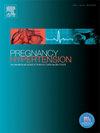Effect of supine or semi-recumbent positions on arterial stiffness among pregnant women
IF 2.9
4区 医学
Q2 OBSTETRICS & GYNECOLOGY
Pregnancy Hypertension-An International Journal of Womens Cardiovascular Health
Pub Date : 2025-07-03
DOI:10.1016/j.preghy.2025.101235
引用次数: 0
Abstract
Objective
We aimed to evaluate whether there was a difference in arterial stiffness measurements in supine and semirecumbent positions among pregnant women.
Methods
This was a cross-sectional study in four public hospitals in Uganda. Women were interviewed to capture demographic data and obstetric history before undergoing arterial stiffness examinations using the Arteriograph device (TensioMed, Budapest, Hungary) in supine and semirecumbent positions. Three consecutive measurements were acquired per position and were transformed to gestational age adjusted z-scores for analysis using a two-sample t-test, paired t-test and Pearson correlation coefficients.
Results
We included 194 pregnant women, with median age of 25 years (interquartile rage (IQR), 21–29), and body mass index of 23.9 kg/m2 (IQR, 21.1–27.6). None was smoking or had renal and cardiac diseases. The procedure failure rate was less than 3 %. There were no significant differences in measurements between supine and semirecumbent positions at 11–42 weeks. We found a strong positive correlation between hemodynamic indices performed in supine and semirecumbent positions: aortic pulse wave velocity z-scores (r = 0.84 (95 % CI, 0.77–0.89)) and aortic augmentation index z-scores (r = 0.95 (95 % CI, 0.92–0.97)) at 11–27 weeks’ gestation, and central systolic blood pressure z-scores (r = 0.81 (95 % CI, 0.72–0.87)) and mean arterial pressure z-scores (r = 0.84 (95 % CI, 0.77–0.89)) at 28–42 weeks’ gestation. Repeated measurements taken in same position were strongly correlated throughout gestation.
Conclusion
Arterial stiffness parameters measured in supine and semirecumbent positions were comparable and had very minimal failure rates. As a supine position is often not tolerated well in late gestation, our study suggests that pregnant women could assume a semirecumbent position during Arteriograph test procedures between 11 and 42 weeks of gestation.
仰卧位或半卧位对孕妇动脉僵硬的影响
目的:我们旨在评估孕妇在仰卧位和半卧位时动脉硬度测量是否存在差异。方法对乌干达四所公立医院进行横断面研究。在使用动脉造影仪(TensioMed, Budapest, Hungary)以仰卧位和半卧位接受动脉硬度检查之前,对妇女进行了访谈,以获取人口统计学数据和产科病史。每个体位获得三个连续测量值,并转换为胎龄调整后的z分数,以便使用双样本t检验、配对t检验和Pearson相关系数进行分析。结果纳入194例孕妇,中位年龄25岁(四分位间距(IQR), 21 ~ 29岁),体重指数23.9 kg/m2 (IQR, 21.1 ~ 27.6)。没有人吸烟或患有肾脏和心脏疾病。手术失败率小于3%。11-42周时,仰卧位和半卧位的测量结果无显著差异。我们发现,仰卧位和半仰卧位的血流动力学指标之间存在很强的正相关:妊娠11-27周时主动脉脉搏波速度z-评分(r = 0.84 (95% CI, 0.77-0.89))和主动脉增强指数z-评分(r = 0.95 (95% CI, 0.92-0.97)),妊娠28-42周时中心收缩压z-评分(r = 0.81 (95% CI, 0.72-0.87))和平均动脉压z-评分(r = 0.84 (95% CI, 0.77-0.89))。在整个妊娠期间,在同一位置进行的重复测量具有很强的相关性。结论仰卧位和半卧位测量的动脉刚度参数具有可比性,且失败率极低。由于仰卧位在妊娠后期往往不被很好地接受,我们的研究建议孕妇在妊娠11至42周的动脉造影检查过程中可以采用半仰卧位。
本文章由计算机程序翻译,如有差异,请以英文原文为准。
求助全文
约1分钟内获得全文
求助全文
来源期刊

Pregnancy Hypertension-An International Journal of Womens Cardiovascular Health
OBSTETRICS & GYNECOLOGYPERIPHERAL VASCULAR-PERIPHERAL VASCULAR DISEASE
CiteScore
4.90
自引率
0.00%
发文量
127
期刊介绍:
Pregnancy Hypertension: An International Journal of Women''s Cardiovascular Health aims to stimulate research in the field of hypertension in pregnancy, disseminate the useful results of such research, and advance education in the field.
We publish articles pertaining to human and animal blood pressure during gestation, hypertension during gestation including physiology of circulatory control, pathophysiology, methodology, therapy or any other material relevant to the relationship between elevated blood pressure and pregnancy. The subtitle reflects the wider aspects of studying hypertension in pregnancy thus we also publish articles on in utero programming, nutrition, long term effects of hypertension in pregnancy on cardiovascular health and other research that helps our understanding of the etiology or consequences of hypertension in pregnancy. Case reports are not published unless of exceptional/outstanding importance to the field.
 求助内容:
求助内容: 应助结果提醒方式:
应助结果提醒方式:


